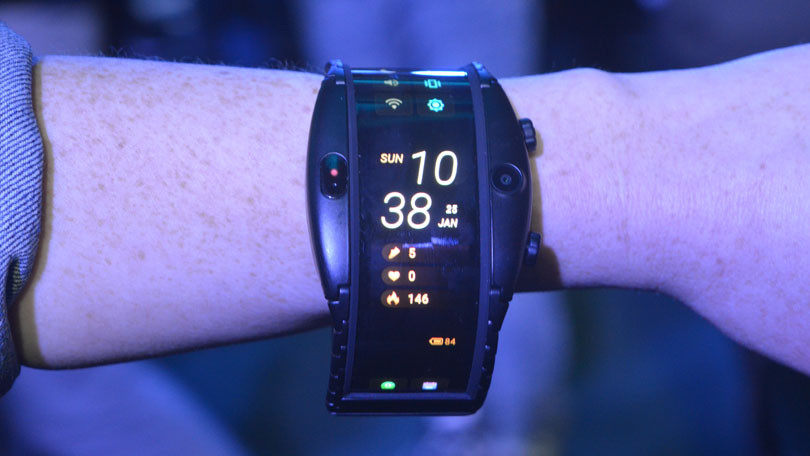
In theory, and from a distance, the Nubia Alpha wearable smartphone looks and sounds innovative. It has a flexible display that you can navigate using air gestures, eSIM technology to replace your primary phone, and a large battery.
MWC 2019 Bug (alt)But up close, it doesn’t live up to the hype. Not only does it look clunky and cheap on the wrist but the interface is overwhelming. Starting at 450 euros ($510), it’s also too pricey for what it offers.
While the novelty of the Nubia Alpha lies in the fact that it’s part wearable, part smartphone, it does come in two different versions. A Bluetooth model connects to a smartphone, while the eSIM version allows you to use the Nubia Alpha as your main phone—make phone calls and video calls, send text messages, and use it for navigation and contactless payments.
Design and Display
The Nubia Alpha features a 4-inch OLED wraparound display with 960-by-192-pixel resolution and 244ppi. Even in a dark room, I had no trouble viewing what was on the screen and the colors were bright and crisp. To the right of the case are two buttons—the top brings you to the home screen while the bottom one triggers Nubia Voice, the company’s personal voice assistant.
The rounded, stainless steel body felt too thick on my small wrist, and I couldn’t help but notice how far the buttons stuck out from the side. The wristband was also too big, but you can manually detach the links to find the right fit. In addition to a black stainless steel color, you’ll also have the option to choose an 18K gold option instead.
In terms of durability, the Alpha is water-resistant and the display is coated in a protective layer of polyimide. It’s also been run through a variety of tests over 100,000 times, such as bending, folding, and distortion to test its strength.
The Alpha fits a lot of information on its large display, to the point that it felt endless and jam-packed. It helps that the watch faces are customizable, though, so you can move different components wherever you’d like on the screen in order to make it easier to digest.
Specs, Software, and Battery
Nubia’s Alpha comes equipped with a 5MP camera and different shortcuts. For instance, to take a photo, simply tap anywhere on the screen to trigger the shutter button and long-press to record a video. But unless you’re taking a selfie, it feels a little awkward to hold your wrist out in order to take a photo of a particular subject. You can also view all your photos via the gallery right from your wrist.
Under the hood is Qualcomm’s Snapdragon 2100 running Nubia’s own operating system. Even with an older chipset like the 2100, running through the menu options felt fluid. Unfortunately, I can’t say the same for the air interaction mechanics—which allow you to navigate the watch by swiping up, down, left, and right through the air. At times, it was unresponsive for a specific direction so I had to use the touch screen. But it’s a cool feature that sets it apart from other smartwatches on the market.
The wearable comes with 1GB of RAM and 8GB of onboard memory. Nubia says this is enough to hold over 900 songs, 6,000 pictures, and 2,000 short videos. As for its battery, the Alpha houses a 500mAh battery, which the company claims can last one to two days with regular use. On standby time, you’ll get up to a week’s worth of juice.
As far as fitness features go, the wearable can monitor heart rate, as well as track exercise and sleep quality.
The Bluetooth version of the Nubia Alpha will be available worldwide in April in black stainless steel starting at 449 euros (roughly $510). The eSIM version will be available in Europe in the third quarter of this year and in the US within the fourth quarter; the black stainless steel model will cost 549 euros (roughly $623) and the 18K gold plated version will cost 649 euros (roughly $737).
























